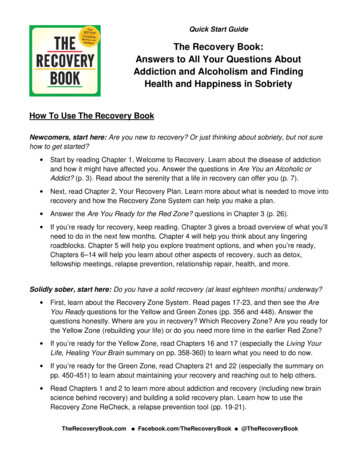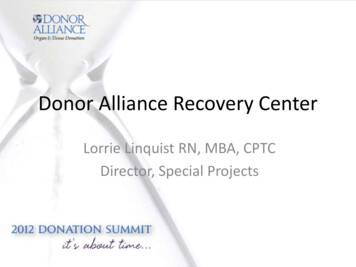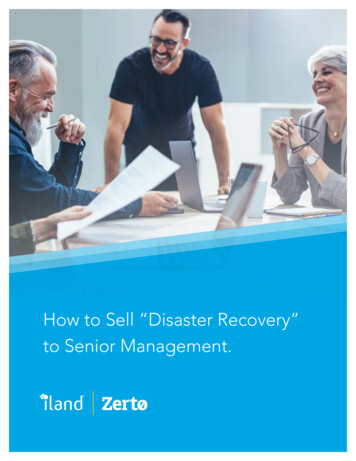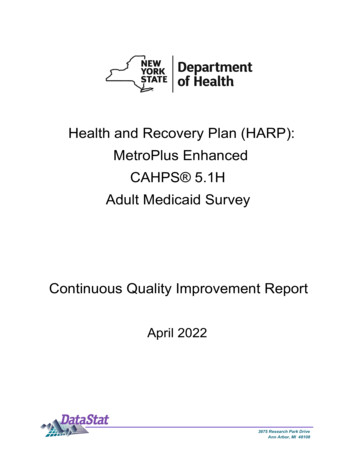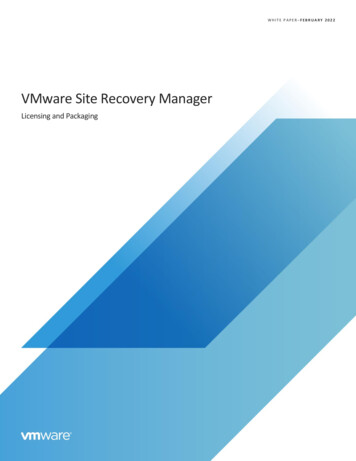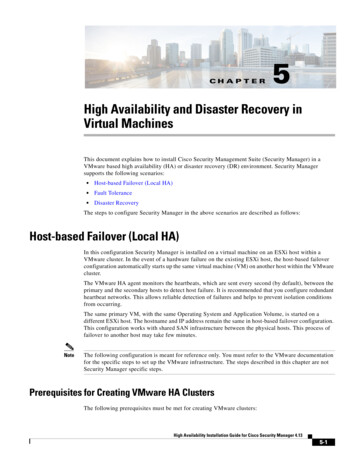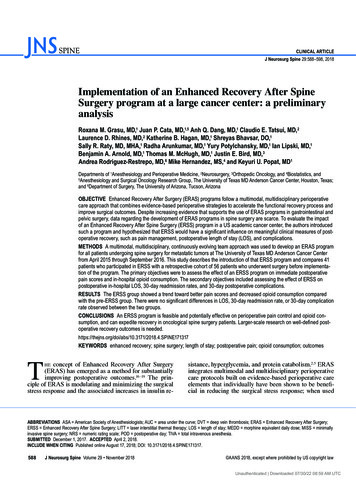
Transcription
CLINICAL ARTICLEJ Neurosurg Spine 29:588–598, 2018Implementation of an Enhanced Recovery After SpineSurgery program at a large cancer center: a preliminaryanalysisRoxana M. Grasu, MD,1 Juan P. Cata, MD,1,5 Anh Q. Dang, MD,1 Claudio E. Tatsui, MD,2Laurence D. Rhines, MD,2 Katherine B. Hagan, MD,1 Shreyas Bhavsar, DO,1Sally R. Raty, MD, MHA,1 Radha Arunkumar, MD,1 Yury Potylchansky, MD,1 Ian Lipski, MD,1Benjamin A. Arnold, MD,1 Thomas M. McHugh, MD,1 Justin E. Bird, MD,3Andrea Rodriguez-Restrepo, MD,6 Mike Hernandez, MS,4 and Keyuri U. Popat, MD1Departments of 1Anesthesiology and Perioperative Medicine, 2Neurosurgery, 3Orthopedic Oncology, and 4Biostatistics, and5Anesthesiology and Surgical Oncology Research Group, The University of Texas MD Anderson Cancer Center, Houston, Texas;and 6Department of Surgery, The University of Arizona, Tucson, ArizonaOBJECTIVE Enhanced Recovery After Surgery (ERAS) programs follow a multimodal, multidisciplinary perioperativecare approach that combines evidence-based perioperative strategies to accelerate the functional recovery process andimprove surgical outcomes. Despite increasing evidence that supports the use of ERAS programs in gastrointestinal andpelvic surgery, data regarding the development of ERAS programs in spine surgery are scarce. To evaluate the impactof an Enhanced Recovery After Spine Surgery (ERSS) program in a US academic cancer center, the authors introducedsuch a program and hypothesized that ERSS would have a significant influence on meaningful clinical measures of postoperative recovery, such as pain management, postoperative length of stay (LOS), and complications.METHODS A multimodal, multidisciplinary, continuously evolving team approach was used to develop an ERAS programfor all patients undergoing spine surgery for metastatic tumors at The University of Texas MD Anderson Cancer Centerfrom April 2015 through September 2016. This study describes the introduction of that ERSS program and compares 41patients who participated in ERSS with a retrospective cohort of 56 patients who underwent surgery before implementation of the program. The primary objectives were to assess the effect of an ERSS program on immediate postoperativepain scores and in-hospital opioid consumption. The secondary objectives included assessing the effect of ERSS onpostoperative in-hospital LOS, 30-day readmission rates, and 30-day postoperative complications.RESULTS The ERSS group showed a trend toward better pain scores and decreased opioid consumption comparedwith the pre-ERSS group. There were no significant differences in LOS, 30-day readmission rate, or 30-day complicationrate observed between the two groups.CONCLUSIONS An ERSS program is feasible and potentially effective on perioperative pain control and opioid consumption, and can expedite recovery in oncological spine surgery patients. Larger-scale research on well-defined postoperative recovery outcomes is PINE171317TKEYWORDS enhanced recovery; spine surgery; length of stay; postoperative pain; opioid consumption; outcomesconcept of Enhanced Recovery After Surgery(ERAS) has emerged as a method for substantiallyimproving postoperative outcomes.16–19 The principle of ERAS is modulating and minimizing the surgicalstress response and the associated increases in insulin rehesistance, hyperglycemia, and protein catabolism.2,5 ERASintegrates multimodal and multidisciplinary perioperativecare protocols built on evidence-based perioperative careelements that individually have been shown to be beneficial in reducing the surgical stress response; when usedABBREVIATIONS ASA American Society of Anesthesiologists; AUC area under the curve; DVT deep vein thrombosis; ERAS Enhanced Recovery After Surgery;ERSS Enhanced Recovery After Spine Surgery; LITT laser interstitial thermal therapy; LOS length of stay; MEDD morphine equivalent daily dose; MISS minimallyinvasive spine surgery; NRS numeric rating scale; POD postoperative day; TIVA total intravenous anesthesia.SUBMITTED December 1, 2017. ACCEPTED April 2, 2018.INCLUDE WHEN CITING Published online August 17, 2018; DOI: 10.3171/2018.4.SPINE171317.588J Neurosurg Spine Volume 29 November 2018 AANS 2018, except where prohibited by US copyright lawUnauthenticated Downloaded 07/30/22 08:59 AM UTC
Grasu et al.together in a single pathway, these individual elements canimprove postoperative outcomes.27 The successful implementation of an ERAS program depends on coordinationbetween all perioperative services involved in patient careacross outpatient, in-hospital, and postdischarge phases.11,18,40 Additionally, constant evaluation of postoperativeoutcomes, including pain control, length of stay (LOS),complications, readmissions, and patient satisfaction, isessential for the program’s ongoing data-driven qualityimprovement strategies.1,3,6,20,25,29,32,34,40The volume and complexity of spine surgeries are rising worldwide.40 Despite improvements in surgical techniques, anesthesia, and perioperative care, major spinesurgery is still associated with significant morbidity andpostoperative pain, decreased postoperative functionalrecovery, and prolonged LOS.3,7,15 There is increasing evidence of benefit from ERAS programs in gastrointestinal,pelvic, and orthopedic surgeries, such as hip and kneereplacement, but there is little information on the development of an enhanced recovery pathway in spine surgery.28,40,41 Given the success of ERAS protocols in reducing morbidity and improving postoperative outcomes inother major surgeries, we hypothesized that an ERAS program tailored to patients undergoing spine surgery wouldhave similar benefits. In our institution, we implemented amultimodal, multidisciplinary Enhanced Recovery AfterSpine Surgery (ERSS) program for patients undergoingspine surgery for metastatic tumors.In this study, we reviewed postoperative outcomes before and after the implementation of ERSS. We hypothesized that the implementation of an ERSS program improved pain management, reduced postoperative LOS (asurrogate measure of postoperative inpatient recovery),and decreased the rate of postoperative complications.MethodsERAS Program ComponentsAfter reviewing the existing literature on successfulERAS programs and consulting with several national andinternational experts on ERAS, we formed a multidisciplinary ERSS committee comprising representatives inneuroanesthesia, neurosurgery, nursing, and other services, such as physical medicine and rehabilitation and nutrition. The committee developed a program built on an evidence-based approach to improve the perioperative careof patients undergoing spine surgery at The University ofTexas MD Anderson Cancer Center. A standardized protocol was created to guide the perioperative managementof spine surgery patients, and we prospectively collectedperioperative data in a REDCap database.10The ERSS program was introduced over severalmonths and considered fully operational by April 2015.The committee met weekly to discuss, revise, and monitoradherence to the protocol. Although the ERSS protocolwas provided to and discussed with members of all theperioperative services, the provider ultimately decidedwhether to deviate from the protocol if deemed necessaryor clinically indicated.The ERSS protocol (Table 1) is a comprehensive plancovering the continuum of care from preoperative prepa-ration to intraoperative management to postoperative recovery. The preoperative protocol includes patient education, preconditioning exercise, optimization of comorbidities by the oncological primary care and specialty teams,and oral intake guidelines that allow patients to drinkclear liquids up to 2 hours before the surgery. In the immediate preoperative period, patients receive oral analgesicsconsisting of acetaminophen (1000 mg), extended-releasetramadol (300 mg), and either pregabalin (75–150 mg) orgabapentin (100–300 mg) unless administration is contraindicated. Intraoperatively, the protocol recommends 1)total intravenous anesthesia (TIVA) with bispectral indexmonitoring for guidance on anesthesia depth; 2) infusionsof lidocaine, ketamine, and dexmedetomidine; 3) regularly scheduled intravenous acetaminophen; 4) epiduralanalgesia or liposomal bupivacaine for surgical wound infiltration; 5) goal-directed fluid therapy and hemodynamicoptimization; 6) restrictive blood transfusion and the useof tranexamic acid; 7) risk-based antiemetic prophylaxis;8) deep vein thrombosis (DVT) prophylaxis; and 9) maintenance of normothermia. The intraoperative surgery element evolved toward a change in practice with the development, improvement, and preferential use of minimallyinvasive techniques when clinically appropriate. The postoperative component includes specific guidelines for minimization of opioid consumption, DVT prophylaxis, earlyoral intake starting on postoperative day (POD) 1, earlyambulation, and physical therapy.Study GroupsAfter IRB approval, we conducted a retrospective studyof consecutive patients at our institution who underwentspine surgery for metastatic tumor resection before (preERSS group, or control group) and after (ERSS group) theimplementation of the program in April 2015. We collected demographic and perioperative data from all patientsin the study. We included patients 18 years old who underwent spine surgery for metastatic spine tumors undergeneral anesthesia whose medical records had completepostoperative pain data. The surgery type included opensurgery such as decompression, stabilization, and/or vertebrectomy, and minimally invasive spine surgery (MISS)such as transcutaneous vertebroplasty and/or stabilization.We excluded patients with primary spine tumors, emergency surgery, laser interstitial thermal therapy (LITT)procedures, or incomplete pain score data. Patients in thepre-ERSS group typically received conventional balancedgeneral anesthesia using a combination of volatile agents,intravenous anesthetics, and infusion of opioids accordingto clinical judgment. Both groups had similar preoperativeoptimization of comorbidities, management of complications, and hospital practice/discharge criteria.Outcome MeasurementThe primary outcomes were postoperative pain scores,on a numeric rating scale (NRS) of 0–10, with 0 indicating no pain and 10 indicating the worst possible pain, andpostoperative opioid consumption measured in oral morphine equivalent daily dose (MEDD). We assessed theprimary outcomes for the postoperative periods of PODsJ Neurosurg Spine Volume 29 November 2018589Unauthenticated Downloaded 07/30/22 08:59 AM UTC
Grasu et al.TABLE 1. ERSS versus conventional pathwaysERSS PathwayConventional PathwayPreopEducation including General postop information (online video); additional ERSS education provided in the neuroguidance on presurgery clinic, & handouts include specific information about enhanced recovery principles,habilitation whenpatient & caregiver expectations, & opioid minimization pain management; emphasis onappropriaterelevant preconditioning exercisesSedation & anxiety Consider consult for cognitive behavioral therapy, meditation, yoga, music therapy, &/or herbal/managementsupplement use for consistently moderate MDASI, VAS, NRS scores 4–6; consider psychiatry consult first for MDASI consistently 6Pain management Surgery preparation: Consider pain consult if anticipated difficult to control postop pain; patienton 5 opioid tablets/day; patient on long-acting opioid medication; rapidly increasing opioidrequirements; pain not responsive to prescribed analgesics; patient treated by an outsidepain physician; significant psychosocial distress related to pain &/or surgery; current or history of recreational drugs use. Consider starting w/ low-dose (e.g., 100 mg/daily) gabapentinfor neuropathic pain & patient 65 yrs of ageDay of surgery: tramadol ER 300 mg orally gabapentin 300 mg (or pregabalin 75 mg) orally acetaminophen 1000 mg orally upon arrival in preoperative holding area; consider decreasing dosage if patient 65 yrs oldPreop fastingClear liquids permissible up to 2 hrs before surgery except in cases in which there is a higherrisk of aspiration (e.g., post-esophagectomy) up to 4 hrs before surgery; use carbohydrateloading guidelinesIntraopAnesthesia &IV anesthesia maximization: infusions of propofol, dexmedetomidine, ketamine, lidocaine (intentmedicationsto get to TIVA); methadone (0.1–0.2 mg/kg) single upfront IV dose in opioid-tolerant patients;IV dexamethasone 10 mg every 6 hrs; consistent risk-based antiemetic, & DVT prophylaxis;emphasis on lung-protective mechanical ventilation strategiesFluid management Individualized goal-directed fluid therapy based on surgical & patient risk factorsTransfusion man- Minimize utilization of blood products; transfuse only if hemoglobin 9–10 g/dl depending onagementcomorbidities & hemodynamic stability; if utilized 2:1 prbc/ffp ratio or 1:1 for massive transfusion; consider tranexamic acid 1 g bolus over 30 min followed by 0.5 g/hr infusion; considerpreop arterial embolization for high-risk bleeding tumors (renal, thyroid)TemperatureConstant body temperature monitoring throughout the surgery & actively attempt to keep temmanagementperature above 36 C using hot air blankets, warming mattresses, fluid warmersSurgical consider- MISS techniques preferred when clinically feasible; emphasis on injection of liposomal bupivaationscaine at incision site or epidural placed under direct visionGeneral postop information(online video)Conventional anxiolyticsIndividual provider preferenceNo oral intake for 8 hrs beforeplanned surgeryIndividual provider preferenceIndividual provider preferenceIndividual provider preferenceNot performed w/ consistencyIndividual provider preference; rarely used MISS orliposomal bupivacainePostopPlastic surgeryLocal flap, no restriction on ambulationIndividual provider preferenceEarly ambulation & Out of bed POD 1; movement 3 times daily, bed to chair, chair to bed at minimum assist levelNot consistently done w/PT/OTBy discharge: ambulate at minimum assist level for 50 ft w/ or w/o an assistive device; if nonamfrequencybulatory (i.e., wheelchair bound), bed to chair, chair to bed transfers at minimum assist levelICU/floorMinimize ICU admissions; emphasis on extubation at the end of surgery; start incentive spirom- Individual provider preference;etry in PACUpatient not consistentlyextubated at end of surgeryPain manageGabapentin 300 mg orally every 8 hrs, celecoxib 200 mg orally every 12 hrs, tramadol ER 200 Individual provider preferencement (generalmg orally every 12 hrs, acetaminophen 1 g orally every 6 hrs, continue preop long-actingprotocol)opioids plus IV PCA; cancer pain consult if pain poorly controlled, daily hydromorphonerequirement 12 mg/day or morphine 60 mg/day, pain limits daily function/rehabilitation,significant psychosocial distressPain management Engage pain consult service for patient-reported outcome approaching “unmanageable”;Not traditionally used(patient-specificconsider consult for cognitive behavioral therapy, meditation, yoga, music therapy, or herbal/needs protocol)supplement use for consistently moderate MDASI, VAS, NRS scores 4–6; consider psychiatry first for patient w/ MDASI consistently 6Early oral intakePatients allowed & begin clear liquids on day of surgery (POD 0); diet advanced as toleratedPatients begin clear liquids onPOD 1 & diet advanced astolerated thereafterffp fresh frozen plasma; ICU intensive care unit; IV intravenous; MDASI MD Anderson Symptom Inventory Scale, a multi-symptom patient-reported outcomemeasure for clinical and research use; PACU postanesthesia care unit; PCA patient-controlled analgesia; prbc packed red blood cells; PT/OT physical therapy/occupational therapy; VAS pain visual analog scale.590J Neurosurg Spine Volume 29 November 2018Unauthenticated Downloaded 07/30/22 08:59 AM UTC
Grasu et al.0–3 and the discharge day. The secondary outcomes werepostoperative hospital LOS, hospital readmission rate, andpostoperative complications. Postoperative LOS was defined as the time from completion of surgery to hospitaldischarge. Readmission was defined as hospital readmission for any cause within 30 days of discharge. Postoperative complications were defined as any medical or surgicalcomplications within 30 days of surgery.Statistical AnalysisDescriptive statistics such as the mean (standard deviation) and median (range) summarized continuous variables. Frequencies and percentages summarized categorical variables. An independent samples t-test, or Wilcoxonrank-sum test if more appropriate, was used to comparecontinuous variables between ERSS and pre-ERSS patients. A chi-square test, or Fisher’s exact test if more appropriate, was used to compare categorical variables between ERSS and pre-ERSS patients.Intrapatient changes in pain scores were computedrelative to POD 0. The absolute changes were categorizedas favorable (for positive changes), neutral (for zero difference), and unfavorable (for negative changes). Becausevarying numbers of pain assessments were elicited frompatients, both maximum and average pain scores werecaptured to better quantify patients’ pain experiences. Forpain scores and total oral MEDD measured longitudinallyover time, the area under the curve (AUC) was computedfor patients using the trapezoidal rule. Patients with complete information from PODs 0–3 and at discharge wereused to compute the mean AUC, and mean AUCs werecompared between ERSS and pre-ERSS patients. Spearman’s rank correlation coefficient was used to assess thestrength of association between the AUC for pain scoresand the AUC for MEDD.Because the distribution of LOS was highly skewed, anatural logarithmic transformation was applied to normalize the distribution. Linear regression was used followedby exponentiation of parameter estimates to acquire geometrical means associated with LOS. A p value 0.05was considered statistically significant, and analyses wereperformed using Stata software (version 13, StataCorp).ResultsPatient PopulationOf the 97 patients included, 41 patients were in theERSS group and 56 patients were in the pre-ERSS group.Relevant patient demographic characteristics are shown inTable 2. Additional surgical characteristics are displayedin Table 3. No significant differences between groups (Table 2) were identified with regard to age, gender, AmericanSociety of Anesthesiologists (ASA) class, comorbidities,or smoking status. The mean ( SD) BMI (kg/m2) wasslightly lower in the ERSS group (25.5 4.9 kg/m2) thanin the pre-ERSS group (28.5 5.7 kg/m2, p 0.007). TheERSS group had a shorter surgical time (263.9 128.0min) than the pre-ERSS group (315.8 152.1 min, p 0.080). The percentages of patients with preoperative painwere similar between groups (90% in ERSS vs 93% inpre-ERSS, p 0.644). The study surgery location and thelocation of the primary tumor were heterogeneous (Table3). With respect to surgery location, thoracic (41%), lumbar (22%), and thoracolumbar (15%) comprised the majority of locations observed. Kidney (21%), lung (18%), andbreast (10%) were the most common primary tumors. TheERSS group had more breast (12% vs 8%) and lung (22%vs 16%) tumors, while the pre-ERSS group had more kidney (25% vs 15%, p 0.698) primary tumors. The majority, and similar percentage, of patients in both groups had1-stage surgery (96%) and 3 or more spine levels operated (84%). However, a significantly greater percentageof ERSS patients underwent MISS (27% ERSS vs 2%pre-ERSS, p 0.001). The majority of open spine surgerycategories observed included decompression only (19%),decompression/stabilization (14%), and decompression/stabilization/vertebrectomy (41%).Adherence of Providers to the Program’s Preoperativeand Intraoperative Multimodal AnalgesiaA higher percentage of patients in the ERSS groupreceived preoperative nonopioid analgesics (39.0% vs10.7%, p 0.001), including gabapentinoids and tramadol.With regard to anesthetic technique, the ERSS group usedTIVA at a greater rate than the pre-ERSS group (22.0% vs7.1%, p 0.050). The ERSS group also showed increasedintraoperative rates of lidocaine (42% vs 14%, p 0.003)and ketamine infusions (51% vs 29%, p 0.023), whilethe frequency of dexmedetomidine use was only slightlyhigher in the ERSS group than in the pre-ERSS group.The percentage of patients receiving epidural analgesiawas not significantly different (ERSS 9.8% vs pre-ERSS8.9%, p 1.000). However, we observed more use of liposomal bupivacaine for infiltration of the surgical wound inthe ERSS group (54% vs 30%, p 0.021).Pain Scores and Opioid ConsumptionTable 4 summarizes the results for the primary and secondary outcome measures. By POD 1, there was some separation between the mean pain scores of the two groups,although this difference was not statistically significant.At POD 2 (p 0.065), POD 3 (p 0.027), and discharge,the ERSS group had lower average pain scores than thepre-ERSS group (Table 4, Fig. 1). A similar trend wasidentified for maximum pain scores, but statistical significance was not achieved (Table 4, Fig. 2). The proportion ofpatients experiencing superior pain control was higher forthe ERSS group than the pre-ERSS group. Additionally,examination of the AUC using a complete case analysisindicated that the mean AUC for the average pain scoreexperienced was significantly lower for ERSS patients (p 0.043; Table 4).The median total MEDD (PODs 0–3) was 372.2 mgfor the ERSS group and 521.5 mg for the pre-ERSS group(p 0.507). Although the MEDD distribution was highlyskewed and contained outliers, the ERSS patients receivedless total morphine. There was a significant Spearman’srank correlation (rho 0.47, n 78, p 0.001) between theAUC of average pain scores and total MEDD for PODs0–3. Additionally, a significant Spearman’s rank correlation (rho 0.42, n 78, p 0.001) between the AUC ofJ Neurosurg Spine Volume 29 November 2018591Unauthenticated Downloaded 07/30/22 08:59 AM UTC
Grasu et al.TABLE 2. Characteristics of study participantsCharacteristicAge, yrsMean SDMedian (range)Sex, no. (%)FemaleMaleBMI, kg/m2Mean SDMedian (range)Surgical time, minMean SDMedian (range)Preop pain, no. (%)NoYesASA class, no. (%)234Chronic cardiovascular disease, no. (%)¶NoYesChronic pulmonary disease, no. (%)NoYesDiabetes mellitus, no. (%)NoYesHistory of smoking, no. (%)Current/past**NoneERSS (n 41)Pre-ERSS (n 56)p ValueTotal (n 97)0.591*58.8 11.359 (28–80)57.6 10.560 (31–78)58.1 10.859 (28–80)0.292†19 (46.3)22 (53.7)20 (35.7)36 (64.3)25.5 4.925.4 (15.7–38.6)28.5 5.728.1 (18.8–43.9)39 (40.2)58 (59.8)0.007*27.2 5.627.4 (15.7–43.9)0.075§263.9 128.0227 (87–552)315.8 152.1321.5 (47–954)293.8 144.0275 (47–954)0.644†4 (9.8)37 (90.2)4 (7.1)52 (92.9)1 (2.4)38 (92.7)2 (4.9)1 (1.8)55 (98.2)0 (0.0)39 (95.1)2 (4.9)55 (98.2)1 (1.8)40 (97.6)1 (2.4)52 (92.9)4 (7.1)8 (8.2)89 (91.8)0.323‡2 (2.1)93 (95.9)2 (2.1)0.572‡94 (96.9)3 (3.1)0.393‡92 (94.8)5 (5.2)0.395†35 (85.4)6 (14.6)44 (78.6)12 (21.4)6 (14.6)35 (85.4)8 (14.3)48 (85.7)79 (81.4)18 (18.6)0.962†14 (14.4)83 (85.6)* t-test.† Chi-square test.‡ Fisher exact test.§ Wilcoxon rank-sum test.¶ Chronic cardiovascular disease includes myocardial infarction, congestive heart failure, peripheral vascular disease, and cerebrovascular disease.** Past smokers were defined as those who had quit smoking within 1 year.maximum pain scores and total MEDD for PODs 0–3 wasnoted. These analyses supported our finding that patientswith higher pain trajectories characterized by the AUCalso had higher total MEDDs (across PODs 0–3).Length of Stay, 30-Day Readmission Rate, and 30-DayComplication RatePatients receiving ERSS had a geometrical mean LOSof 6.3 2.2 days, while the pre-ERSS group had a slightlylonger LOS of 6.8 1.9 days (p 0.590). The ratio of thepre-ERSS to ERSS geometrical means was approximately 1.08 (95% confidence interval 0.81–1.43) and suggeststhat pre-ERSS patients stayed 8% longer in the hospitalon average (Table 4). ERSS patients had a slightly higher59230-day hospital readmission rate than pre-ERSS patients(14.6% vs 8.9%, p 0.381; Table 4).The 30-day complication rate was 31.7% for ERSS patients and 17.9% for pre-ERSS patients (p 0.113; Table4). The most common 30-day complications were cardiovascular (17%) and respiratory (9.7%) for the ERSS groupand infectious (7.1%) and renal (5.4%) for the pre-ERSSgroup.DiscussionTo our knowledge, the present study is the first to report the implementation of a multimodal, multidisciplinary, enhanced recovery program for spine surgery and todescribe its influence on several meaningful recovery out-J Neurosurg Spine Volume 29 November 2018Unauthenticated Downloaded 07/30/22 08:59 AM UTC
Grasu et al.TABLE 3. Additional surgical characteristicsCharacteristicSurgery cicThoracic-lumbarLumbar-sacralPrimary tumor Malignant bone tumorOther*Staged procedureNoYesSpine levels operated1–2 levels3 or moreType of surgeryMISSOpen spine surgeryDecompression onlyStabilization tabilization/vertebrectomyERSS(n 41)Control(n 56)2 (4.9)17 (41.5)8 (19.5)1 (2.4)1 (2.4)9 (21.9)3 (7.3)8 (14.3)23 (41.1)13 (23.2)1 (1.8)4 (7.1)6 (10.7)1 (1.8)5 (12.2)9 (21.9)6 (14.6)1 (2.4)3 (7.3)1 (2.4)0 (0)16 (39.0)4 (7.8)8 (15.7)13 (25.5)3 (5.9)2 (3.9)2 (3.9)2 (3.9)17 (33.3)40 (97.6)1 (2.4)53 (94.6)3 (5.4)pValueTotal(n 97)0.32210 (10.3)40 (41.2)21 (21.6)2 (2.1)5 (5.1)15 (15.5)4 (4.1)0.6989 (9.8)17 (18.5)19 (20.6)4 (4.3)5 (5.4)3 (3.3)2 (2.2)33 (35.9)0.63693 (95.9)4 (4.1)0.4125 (12.2)36 (87.8)11 (19.6)45 (80.4)16 (16.5)81 (83.5) 0.00111 (26.8) 1 (1.8)30 (73.2) 55 (98.2)6 (14.6) 12 (21.4)0 (0.0)1 (1.8)4 (9.8) 10 (17.9)12 (12.4)85 (87.6)18 (18.6)1 (1.0)14 (14.4)2 (4.9)3 (5.4)5 (5.2)3 (7.3)4 (7.1)7 (7.2)15 (36.6) 25 (44.6)40 (41.2)All data given as number (percentage) unless otherwise indicated. The p valuewas based on Fisher’s exact test.* Of the 33, 2 were unknown and 1 was not available.comes. We found that the patients who underwent ERSShad a trend toward better pain scores and decreased opioidconsumption compared with the pre-ERSS patients. Weconclude that an ERSS program is feasible and potentiallyeffective in improving postoperative outcomes such aspain control and opioid use in oncological spine surgerypatients.In a 2016 literature review, Wainwright et al. examined the evidence to support the application of individualERAS components and concluded that an ERAS programcould enable patients undergoing major spine surgery torecover more quickly with lower rates of morbidity andimproved long-term outcomes.40 Some recent studies28,41mentioned the development of an enhanced recovery approach for spine surgery; however, they each introducedand described only one ERAS intervention, such as multimodal pain management or an improvement in surgicaltechnique. In a retrospective study, Mathiesen et al. reported that the implementation of a comprehensive, standardized multimodal pain protocol reduced postoperativeopioid consumption and opioid-related adverse events andimproved mobilization after multilevel spine surgery.28 Ina recent case series, Wang et al. reported the developmentand implementation of a MISS approach as part of an action plan for the development of an ERAS spinal fusionprotocol.41Our enhanced recovery program included a multitude of perioperative interventions (Table 1). Preoperatively, patient education, defined expectations, and activepatient participation were essential to the success of theprogram.30 Additionally, we aimed to optimize preoperative pain management and reduce opioid consumption.4,9,14,21–23,31,35–37,39,42 Intraoperatively, anesthetic management included TIVA with propofol, dexmedetomidine,ketamine, and lidocaine infusions and scheduled intravenous acetaminophen for nonopioid analgesia.12,22,36,37 Otheropioid-sparing pain management strategies included surgical wound infiltration with liposomal bupivacaine or epidural placement when indicated and scheduled high-doseintravenous dexamethasone to treat perioperative spinalcord edema.9,21,23,35,41To maintain intraoperative normovolemia, ERSS usesgoal-directed fluid therapy.39 Established guidelines fortransfusion recommend only that providers avoid hemoglobin levels below 8–10 g/dl depending on comorbiditiesand baseline preoperative hemoglobin. Patients with vascular tumors of the spine (e.g., renal or thyroid carcinomametastases) undergo preoperative arterial embolizationas previously described8,24 and intraoperative tranexamicacid administration. The importance of perioperativeDVT prophylaxis, timely and appropriate antibiotic administration, glucose and temperature management, andlung-protective ventilator strategies was repeatedly emphasized to the team. The technological advances andimprovement in surgical techniques, and particularly thedevelopment and implementation of MISS techniques, cansignificantly decrease perioperative morbidity and accelerate recovery.38,40,41 Therefore, MISS was recommendedand preferred when clinically feasible.For postoperative analgesia, patients received intravenous patient-controlled analgesia with a gradual transitionto oral analgesics as needed. Scheduled high-dose steroidswere continued, and oral acetaminophen, gabapentinoids,and tramadol were administered as soon as oral intake wastolerated.38 Early mobilization and diet advancement wereimplemented with strong support from physical medicineand rehabilitation services and from dieticians, respectively.26Our results indicated that a trend toward better postoperative pain control correlated with a downward trendin total opioid consumption in the ERSS group. Reduce
spine surgery for metastatic tumor resection before (pre-ERSS group, or control group) and after (ERSS group) the implementation of the program in April 2015. We collect-ed demographic and perioperative data from all patients in the study. We included patients 18 years old who un-derwent spine surgery for metastatic spine tumors under




